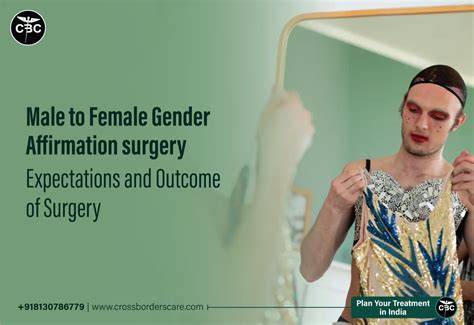Intro
Explore gender affirmation surgery options, including top surgery, bottom surgery, and facial feminization, to support transgender individuals in their transition journey with expert care and precision.
The importance of gender affirmation surgery cannot be overstated, as it provides individuals with a vital means of aligning their physical appearance with their gender identity. For many, this journey is about more than just a medical procedure; it's about achieving a sense of self and belonging. The decision to undergo gender affirmation surgery is deeply personal and can have a profound impact on an individual's mental health, well-being, and overall quality of life. As the medical field continues to evolve, so do the options and techniques available for those seeking gender affirmation surgeries. It's essential for individuals to be well-informed about the various procedures, their benefits, and what to expect during the process.
The journey towards gender affirmation is unique to each individual, and what works for one person may not work for another. This diversity in experience and need necessitates a comprehensive approach to care, one that includes not only surgical options but also psychological support, hormone therapy, and social transition strategies. The goal of gender affirmation surgery is to provide individuals with the physical characteristics that align with their gender identity, thereby enhancing their self-perception and social interactions. This can involve a range of surgeries, from top surgeries that alter the chest to bottom surgeries that focus on the genital area, as well as facial feminization or masculinization procedures.
The process of gender affirmation is complex and multifaceted, requiring careful consideration and planning. Individuals must navigate a healthcare system that, while improving, still often lacks comprehensive understanding and support for transgender and non-binary individuals. Despite these challenges, advancements in medical technology and a growing recognition of the importance of gender-affirming care have led to the development of more sophisticated and personalized surgical options. These advancements aim to minimize recovery time, reduce the risk of complications, and maximize the aesthetic and functional outcomes of the surgeries. As the field continues to evolve, it's crucial for potential patients to stay informed about the latest developments and to seek care from professionals who are experienced in gender affirmation surgeries.
Introduction to Gender Affirmation Surgeries

Benefits of Gender Affirmation Surgeries
The benefits of gender affirmation surgeries are multifaceted, extending beyond the physical to encompass psychological, social, and emotional aspects of an individual's life. Some of the key benefits include: - **Improved Mental Health:** By addressing gender dysphoria, these surgeries can lead to significant improvements in mental health, including reduced symptoms of depression and anxiety. - **Enhanced Self-Esteem:** Aligning one's physical appearance with their gender identity can profoundly impact self-esteem, leading to increased confidence and a more positive self-image. - **Better Social Interactions:** Gender affirmation surgeries can facilitate smoother social interactions by reducing the discomfort or distress that may arise from a mismatch between physical appearance and gender identity. - **Increased Quality of Life:** Overall, these surgeries can lead to a marked improvement in quality of life, as individuals are better able to express themselves authentically and engage fully in their communities.Types of Gender Affirmation Surgeries

Preparation for Gender Affirmation Surgery
Preparation for gender affirmation surgery is a critical and multifaceted process. It involves not only the physical aspects of preparing for surgery but also the psychological and social. Key steps in the preparation process include: - **Consultation with a Healthcare Provider:** Initial consultations with a qualified healthcare provider or surgeon are essential. These meetings provide an opportunity to discuss goals, understand the procedure, and address any questions or concerns. - **Hormone Therapy:** For many, hormone therapy is a precursor to surgery, helping to induce physical changes that align with their gender identity. - **Mental Health Support:** Access to mental health support is vital throughout the transition process. Therapy can provide a safe space to explore feelings, address challenges, and build resilience. - **Social Transition:** Social transition, which may involve changing one's name, pronouns, and social roles, is an integral part of the overall transition process and can begin well before any surgical intervention.Surgical Procedures and Recovery

Challenges and Considerations
While gender affirmation surgeries can be profoundly beneficial, they are not without challenges and considerations. Some of the key issues include: - **Access to Care:** Access to qualified healthcare providers and surgeons experienced in gender affirmation surgeries can be limited, particularly in certain geographic areas. - **Cost and Insurance Coverage:** The cost of these surgeries can be significant, and insurance coverage varies widely. Advocacy for inclusive insurance policies is an ongoing challenge. - **Mental Health:** The transition process, including surgery, can have a profound impact on mental health. Ongoing support and access to mental health services are crucial. - **Social Support:** A strong support system, including family, friends, and community, can make a significant difference in the transition journey.Future Directions in Gender Affirmation Surgery

Conclusion and Next Steps
The journey of gender affirmation is deeply personal and unique to each individual. As the field of gender affirmation surgery continues to evolve, it's essential for those considering these procedures to stay informed, seek support, and advocate for their needs. Whether you're just beginning to explore your options or are well along in your transition journey, remembering that you're not alone and that there are resources available to support you is crucial. By embracing the complexity and diversity of gender identity and expression, we can work towards a future where everyone has the opportunity to live authentically and thrive.What is gender affirmation surgery?
+Gender affirmation surgery refers to medical procedures aimed at altering an individual's physical appearance to align with their gender identity.
What types of gender affirmation surgeries are available?
+Gender affirmation surgeries can include top surgeries (such as mastectomy or breast augmentation), bottom surgeries (like vaginoplasty or phalloplasty), and facial feminization or masculinization procedures.
How do I prepare for gender affirmation surgery?
+Preparation involves consultation with a healthcare provider, possibly hormone therapy, mental health support, and social transition steps. Each individual's preparation process may vary based on their specific needs and circumstances.
